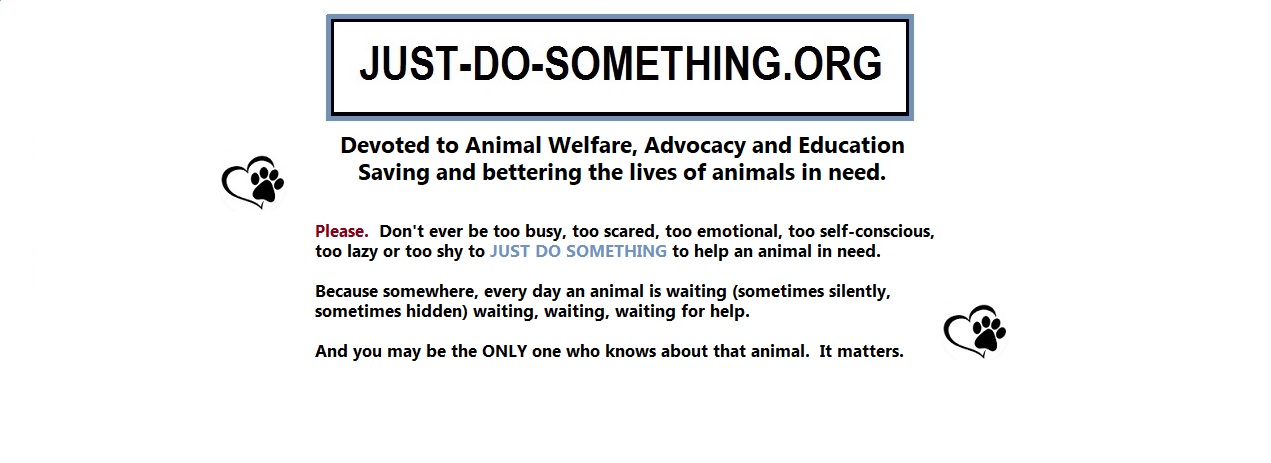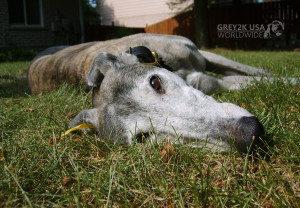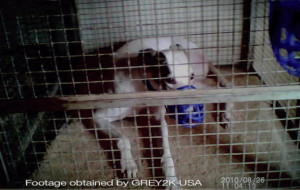April 29, 2014
Guest Blogger, Christine A. Dorchak, Esq. – GREY2K USA
Before you Comment, take a moment to review our guidelines!
The fight to end dog racing worldwide
GREY2K USA is a non-profit team dedicated to passing stronger greyhound protection laws and ending the cruelty of dog racing. I co-founded the organization with political strategist Carey Theil, veterinarian Dr. Jill Hopfenbeck and the Reverend Tom Grey in 2001. We advocate for greyhounds in the legislative and judicial process and also promote the adoption of these gentle hounds worldwide.
The inspiration behind GREY2K USA dates back to 1992, when my dog Kelsey and I were struck by a speeding train while out for a walk one day. Kelsey managed to pull us slightly off course, preventing a head-on collision and saving our lives. When I awoke from a coma, my first words were, “How’s Kelsey?” I promised right then and there that if I could ever walk again, I would devote my life to helping dogs, and that she and I would do this work together.
My dear Kelsey had suffered a broken hip the day of our accident, but she was to live until the age of fifteen, dying just a few days after I finished law school. She helped me through my rehabilitation, four years of evening law classes and the early days of our campaigns, staying by my side as long as she could. It is Kelsey’s inspiration that continues to motivate my work for her fellow dogs each day.
Our Work
In recent years, GREY2K USA has phased-out dog racing in many states and successfully prevented its introduction to countries such as South Africa, Jamaica and the Philippines. The organization’s most rewarding campaign involved a voter referendum in which four million people were asked to shut down the two tracks of our home state. In November 2008, Massachusetts citizens voted overwhelmingly in favor of the greyhounds, starting a chain of events that quickly led to the prohibition of dog racing in our sister states of New Hampshire, Rhode Island and most recently, Colorado.
All told, we have helped close more than half of all US tracks over the last decade, and we are now looking to apply our strategy to help end dog racing worldwide.
The key to our efforts is a reliance on bona fide, official documentation only. Where previous efforts to end dog racing often amounted to a “he-said she-said” debate, today we let the greyhounds to speak for themselves through their own track records and photographs. As government documents show, racing greyhounds spend an average of twenty or more hours a day inside small stacked cages which are barely large enough for them to stand up or turn around. When taken out of their cages to race, these sensitive dogs face the risk of serious injury and death at every turn.
Greyhounds suffer terrible injuries while racing.
At tracks nationwide, greyhounds routinely suffer serious injuries. These include dogs that suffer broken legs and spines, paralysis, head trauma, puncture wounds and death from cardiac arrest.
- At two West Virginia dog tracks, 4,796 greyhound injuries were reported between January 2008 and June 2013. During the same period, 289 dogs died or were destroyed.
- At Southland Greyhound Park in Arkansas, 476 greyhound injuries were reported from January 2008 and December 2013, including at least thirty-three dogs that died or were destroyed.
- At Gulf Greyhound Park in Texas, 2,080 greyhound injuries were reported between January 2008 and December 2013. Eighty-six dogs died or were killed.
- At Bluffs Run and Dubuque Greyhound Parks in Iowa, there were 747 greyhound injuries reported from January 2006 through July 2012.
- In Florida, 74 dogs died at racetracks between May 31 and December 31, 2013. At least one of these dogs was electrocuted.
More than just numbers, these figures tell the stories of individual dogs who lived and died so that a gambler could place a $2 bet on them. One-year-old WW’s Laos who broke his leg at the Wheeling,West Virginia track and was destroyed in one of his first races. He had only left the breeding farm a few months before. SE’s Angel Fire was a two-year-old white and black greyhound who broke her back during a race at the Hollywood track in Florida. She was put down. A red brindle-colored dog named SH Transporter was destroyed after breaking his right front leg at the Dubuque track. He was carried off the track and killed. And LNB Night Mare was a young dog who fell into the electronic lure and died while racing at Tucson Greyhound Park.
Small cages are greyhounds’ only homes.
When not at the track, racing greyhounds endure lives of terrible confinement. They are kept inside warehouse-style kennels inside stacked cages that are barely large enough for them to stand up or turn around — for twenty or more hours a day! There are no toys for them and no play.
The minimum size for dog track cages is 32 inches high by 31 inches wide by 42 inches deep, with some slightly larger. According to the American Greyhound Council, greyhounds stand between 23 inches and 30 inches tall at the shoulder and weigh between fifty and eighty-five pounds. Using these dimensions provided by the industry, this means that large greyhounds cannot stand fully erect in their cages.
Since there are no required turn-out times, the only extended period that a racing greyhound is outside of his cage is when he is trucked over to the track to perform several times a month. Otherwise, life is marked by the four walls of his cage.
This is no way to treat a dog!
Greyhound racing breeds misery.
Beyond the industry standards of confinement, injuries and fatalities, and the killing of young, healthy dogs, the industry has a fundamental problem of perspective: In the eyes of racetrack promoters, dogs are merely short-term investments. Even the fastest dogs can only race for a few years, and are expected to generate enough profit during that time to make up for the cost of their food and housing. The pressure to generate profits can lead to negligent care and outright cruelty such as the use of drugs to alter a dog’s performance.
Another essential problem with dog racing is that thousands of dogs are over-bred every year in an effort to find younger, faster dogs. The older ones are then displaced, and their very lives put in immediate jeopardy. Will they be rescued or will they be destroyed? The lucky ones who do reach adoption will then displace other needy animals (cats, dogs, rabbits, others) also seeking homes. In this significant way, the racing industry aggravates a homeless animal population which is already overwhelming and immensely sad. I believe that best answer is to get to the root of the problem and end dog racing as quickly as possible.
A dying industry.
Even as this cruelty continues, attendance is shrinking by the year. The Association of Racing Commissioners International reports a 67% decline in wagering on dog racing since 2001, the year GREY2K USA was founded. Where there were once nearly fifty dog tracks in fifteen states at that time, today there remain a total of twenty-one facilities operating in seven states. Similarly, state revenue from greyhound racing continues to drop catastrophically. Between 2001 and 2011, state dog racing revenue declined by more than 80% nationwide. In Florida, the country’s biggest dog racing state, regulatory costs have now exceeded revenues by as much as $3.3 million yet dog tracks continue to receive tax breaks and other incentives. States like West Virginia continue to subsidize live racing with tens of millions of dollars per year. This is money that would be better spent on schools, law enforcement, infrastructure and other important community needs.
You can help the greyhounds.
It’s time for a change, and we would like your help in making that change.
Please join us in our fight to end dog racing.
My greyhound is truly one of the lucky ones. As Kelsey before her, Zoe gives life to this struggle and reminds me that every dog deserves to be loved and protected.
To learn more about dog racing, and to work with us to save greyhounds, please go to www.GREY2KUSA.org.
Please sign up for action alerts, find us on Facebook and join the team that is working to give greyhounds the second chance they deserve.
Guest Blogger and Friend, Zoe:
Christine A. Dorchak, Esq.
GREY2K USA President and General Counsel, GREY2K USA












Keep up your amazing work!!! You are doing a great job for these lovely dogs!!!
Keep up the great work, Christine! I have tweeted this article and posted it on Linked-In. Those of us who are working each day to end this kind of cruelty as well as neglect need to band together– there is strength in our unified voices!
Hi. I got this website from my buddy who recommended it to me. Being an animal lover, and also being big on animal rights, it’s a great site to look for the latest petitions going around, and your blogs are diverse and informative. Consider yourself bookmarked!
Delighted to read this blog post, which carries lots of helpful data. Thanks for providing such statistics.
Great blog post.
I drop a comment each time I especially enjoy a article on a site or I have something to add to the conversation. Usually it’s caused by the sincerity displayed in the post I looked at.
I have reached out to you via your Contact page with my comments and a few questions. Really enjoyed viewing your pages.
Hi! I just would like say big thumbs up for the excellent information you post. Consider your website shared and bookmarked!
It’s like you read my mind! This is fantastic blog post. A great read. I’ll certainly be back. Thanks for sharing.
Hello, after reading this awesome post I am happy to share it, and your website, with my colleagues.
Excellent post. I absolutely love this website. Keep it up!